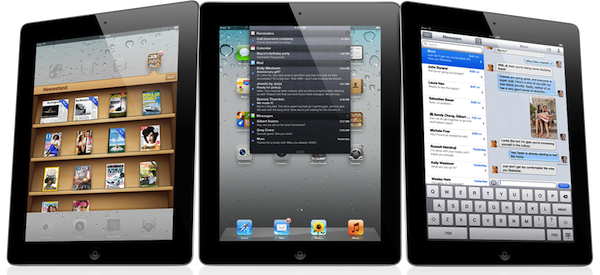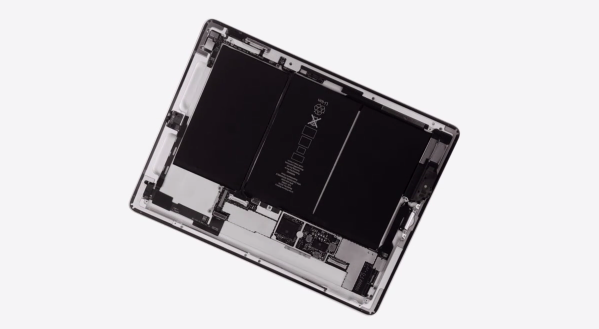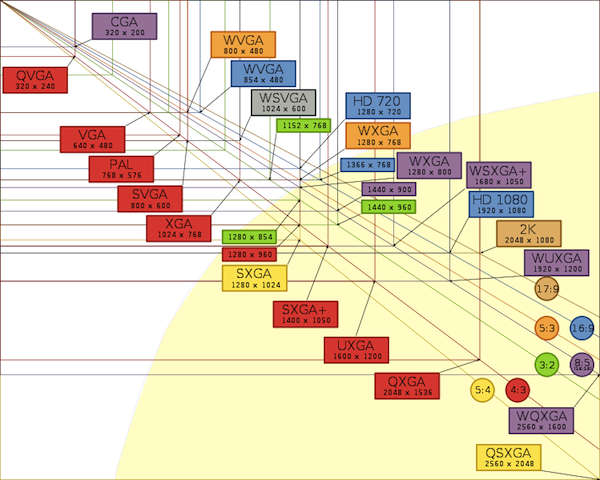With the (rumored) next-generation iPad approaching its (rumored) announcement on March 7th, I thought it would be interesting to collect some of the predictions we’ve made thus far based on the rumors and oft-quoted “inside reports” we have heard until today.
Unlike most Apple product launches, like, say, the iPhone 4S in October, there seems to be a certain degree of certainty in what the device is going to look like and the hardware changes it’ll feature when compared to the existing iPad. Thanks to various parts that have surfaced from China, several mentions by Daring Fireball’s John Gruber, and a general assumption that “it’s about time”, it appears the iPad 3 is going to feature a high-resolution, 2048 x 1536 Retina Display. Just like the jump from iPhone 3G-era displays to the iPhone 4, a Retina iPad (which John Gruber has been predicting since 2011) would allow for crisper graphics on screen and a better reading experience thanks to the increased number of pixels per inch.
Reported in just about any recent rumor on the iPad 3, the Retina Display has become the marquee addition those who follow Apple rumors expect to see in the next-gen device. As we’ve seen with our previous coverage, however, there are other hardware changes that Apple could bring to the iPad 3, namely better cameras, faster processor, and LTE connectivity.
In the past months, I have seen reactions from people who have followed the iPad 3 rumors typically split in two categories:
Theory #1: iPad 3 has Retina Display, new cameras, LTE, new A6 processor.
Theory #2: iPad 3 has Retina Display, slightly improved cameras, faster A5 processor.
The two theories imply that the new iPad is going to be a major revision with dramatically faster CPU and graphics to power the Retina Display plus LTE connectivity, or a speed-bump of the existing iPad with the addition of a Retina Display, but no LTE, dramatically faster processor, or iPhone-class cameras. Both are based on a series of rumors, patterns, and facts to be considered.
First off, the CPU. Whilst a recent photo showed an alleged iPad 3 logic board carrying an Apple-branded “A5X” processor, all rumors to date have pointed to an all-new, quad-core “A6” processor as the foundation for the iPad 3’s Retina Display and sharper graphics. It’s not clear whether or not the authenticity of the photo could confirm a minor update to the existing A5 processor that would follow the naming convention used by the iPhone 3GS and iPhone 4S (put simply, a suffix), but some have already speculated the X could be a clever way of indicating the Retina nature of the device’s display – specifically, developers have to use images with a “@2x” suffix when developing for the Retina Display (example). If that sounds like a bit of a stretch, others have also been quick to point out that A5X could simply be a placeholder name in Apple’s production line – that is, if the photo is to be believed at all.
Revert To Saved had a nice explanation of the Retina iPad rumors:
In the context of the iPhone and iPod touch, a Retina display means a display where it is—for people with standard eyesight—more or less impossible to resolve single pixels on the screen. Instead of jagged text and graphics, the 326ppi screen provides print-like imagery. By contrast, the current iPad is 132ppi—better than most computer displays, but lacking when directly compared to current iPhones and iPods. With the next iPad, the hope is that Apple would up the resolution to 2048-by-1536, and while this wouldn’t have the same pin-sharp qualities as the iPhone and iPod, it would nonetheless be tricky to resolve individual pixels unless holding the iPad closer than is sensible and comfortable. So no playing Sniff the Angry Birds for you, if you want to keep that illusion of smoothness in the graphics.
The problem that is often mentioned when it comes to iPad 3 and Retina Display is that a quad-core CPU would require significantly more power, thus having an impact on battery life and becoming an issue for Apple, as the available space inside an iPad’s case is limited and can only fit three battery packs (see image below, from Apple’s iPad 2 video). On the other hand, however, a screen with four times the available pixels with a double resolution (read our previous Retina Display for iPad analysis here) would require more processing power and RAM, and thus a high-performance mobile CPU. Both concerns are legitimate: Apple hasn’t got much room to tweak the internals of the iPad, and when you add enhanced graphic processing to the mix you risk ending up with a tablet that’s got sharper images, but decreased battery life; similarly, Apple doesn’t like its new gadgets to run poorly, so it’s almost a given that if they’ve found a way to bring a Retina Display to the tablet, they’ve also got the proper, high-performance tech to run it.
Quad-core or not, there are a few things we know for sure: Apple cares about battery life, and miniaturization is a priority at Apple’s hardware labs. As Jobs mentioned at the iPad 2 introduction last year, the thinner form factor didn’t mean Apple had to give up on the original iPad’s “legendary” battery life – a feat that was possible thanks to Apple relying on its own “battery chemistry” (source) and on making things smaller to leave room for batteries. Combined, battery technology and miniaturization have allowed Apple to increasingly shrink the size of its mobile devices and laptops over the years, whilst keeping battery life and performances intact or superior. It’s only safe to assume the same is going to happen with the iPad 3: a design that could only be negligibly thicker, same battery life, same or better performances. Keep in mind, though, that Apple likes speed bumps, even if minor.
As for the name: I believe the “A6” we see in the rumors is simply based on Apple’s previous naming conventions for its SOC processors. For all we know, a tweaked A5 might be enough for the iPad 3, and they might not even call it A6. I would also like to point you to AnandTech’s exhaustive review of the iPad 2 with A5/A4 comparison chart.
Next is LTE. The Apple rumor mill seems to believe the company is either going to adopt LTE connectivity with the iPad 3 or save it as a big new feature of the iPhone 5 – I have already expressed my thoughts about it in a previous story. A few points to keep in mind: LTE on the iPad 3, even if limited to the United States, might be a good way to “test” the carriers, user adoption, and download speeds of iTunes content (more on this in a bit). Verizon and AT&T would certainly offer LTE packages for iPad 3 owners in the United States, and everyone else would simply keep using the device on 3G thanks to its world-mode that doesn’t force Apple to produce multiple versions. Again, there are different reasons for Apple to adopt LTE with iPad 3 or stick with 3G for now: Qualcomm has announced LTE chips with less power consumption and the iPad would be a better device to test LTE as there is more room for experimentation inside (again, in theory, as we’ve discussed above); code strings found in various versions of iOS seem to suggest Apple has code in place for possible LTE support (the same code strings pointed to quad-core CPUs). On the other hand, you could argue that it’s still too soon for LTE, and only some customers in the United States would benefit from it today.
It gets more interesting with the definition of “better” cameras on the iPad 3. Whilst a recent rumor claimed Apple could use an iPhone 4S-like 8 MP camera in the iPad 3, the company didn’t seem to care much about camera quality with the iPad 2, implementing a 1 MP camera that has been deemed “good enough” at best. Whilst anything from 3 MP above would look sufficiently good on the iPad 3’s 2048 x 1536 screen, one has to wonder whether Apple received so many request from users willing to take great photos with an iPad, rather than simply using the device for things such as video calling and augmented reality apps. Data from Flickr suggests people aren’t exactly using their iPads as a photographic tool, and Apple’s own marketing material isn’t really pushing the iPad’s capabilities as a camera. Of course, Apple may still be planning to change this with the iPad 3 and market the device as a revolutionary take on mobile photography, but evidence collected until today suggests the opposite. If anything, it would make sense for Apple to enhance the iPad’s cameras to offer better FaceTime calling – that’s why many rumor observers believe the only camera upgrade the iPad 3 will receive is a FaceTime HD camera on the line of Apple’s recent Mac refreshes.
Rather than speculating on the camera resolution that would make sense on the iPad’s Retina Display, here’s a handy image to put things in perspective:
Assuming the iPad 3 has a Retina Display, I think it would also be safe to assume Apple could bring video recording from 720p to 1080p, while improving the quality of the front-facing camera (currently VGA) – which is used mostly during FaceTime or Skype video calling sessions. As for those who are suggesting Apple should drop the cameras in the next iPad altogether, it’s important to remember that whilst they may not be used much for photographic endeavors, the iPad’s cameras have proved an invaluable tool for FaceTime, and Apple doesn’t typically like to announce they have removed something from a new product. If Apple were to follow its established pattern of slow improvements one after the other, waiting for better cameras on the next iPad seems like a good assumption. It’s just impossible to tell how “better” they will be.
The two theories I stated above are based on four different hardware features that Apple could introduce or improve with the iPad 3. Below, I’ve collected some reactions from Twitter to a question I posted earlier today.
Plus, some interesting points that have also been raised about the iPad 3:
iOS 5.1: Apple could focus the iPad 3’s announcement on things the device can do thanks to new software, rather than hardware alone. Such as Aperture.
Siri: It’s not clear whether the iPhone 4S’ voice-based assistant will find its way on the iPad someday. A recent report suggested Siri was only enabled on the iPhone 4S due to a noise-canceling technology possible thanks to the device’s A5.
Bluetooth 4.0: Apple has been updating all its devices with Bluetooth 4.0 (except the minor late 2011 revision of the MacBook Pro line), and it would only make sense to have the technology on the iPad 3 as well (especially considering it opens the door to some interesting low-energy integrations).
More RAM: Is the iPad 2’s 512 MB enough for a Retina iPad? Likely not. We’ll have to wait and see what “a lot more” means though.
AirPlay Mirroring at 1080p: Currently supports 720p, increased output would play well with the theory below…
1080p iTunes content: With an iPad 3 carrying a Retina Display, Apple could “finally” add 1080p video content to iTunes, a move that could also have the side effect of triggering an Apple TV update to enable 1080p…and improved AirPlay Mirroring for Mac and iOS devices. The speed of LTE could also mean Apple will allow downloads of higher quality content while not on WiFi.
X times faster: The iPad 2 was “nine times faster” in graphic processing than its predecessor. With the iPad being increasingly used as a gaming device, what’s the next A-series processor going to look like from a benchmark standpoint?
NFC: This one used to be front and center in the rumors leading up to the iPhone 4S announcement. Lately, we haven’t heard much about any possible NFC-related announcement. Keep in mind that NFC was wildly speculated upon in relation to mobile payments – and John Gruber hinted Apple was “working like mad on this stuff”. There were some early reports about possible iPhone-to-iPad NFC implementations, and it’d also be interesting to see Apple enter this market with companies such as Square being so successful in it, despite lacking the scale to build a worldwide payment system (which Apple could do, given their resources).
More storage: Apps and games optimized for the Retina Display usually come with more resources (image files), 1080p content could be introduced, and a possible Aperture for iOS would have iPad users keep considerably more photos on their devices. Whilst 64 GB is enough for most people, a 128 GB iPad wouldn’t be too absurd.
iPad 2 is kept around: Another theory has Apple releasing the iPad 3 in March, keeping the iPad 2 around as a still-great option for those not interest in the Retina Display. When the iPad 2 was introduced last year, Apple kept around the iPad 1 for a limited time at $399 (as fas as this theory goes, I tend to agree with something that was recently mentioned on The B&B Podcast – an iPad 2 priced at $299 would trigger the psychological point of “impulse buy” for many).
3
With over 15 million units sold in the last quarter alone, the iPad 2 has been a success for Apple, shaping the post-PC era thanks to its portable form factor, great performances, and outstanding selection of apps. Whether or not Apple will release a minor speed bump or a major hardware revision built around the Retina Display, we look forward to the next iPad as the device that will redefine the rules of the tablet market for the next several years.




